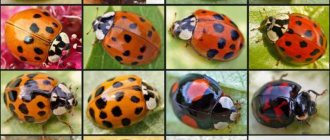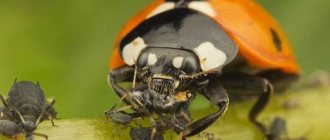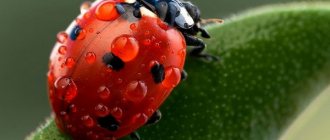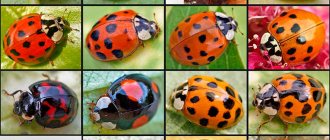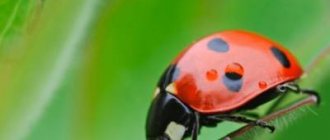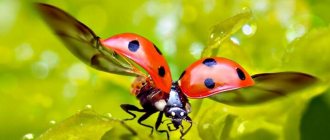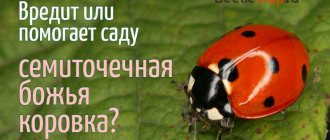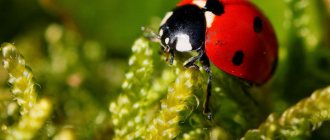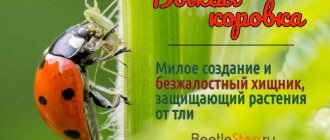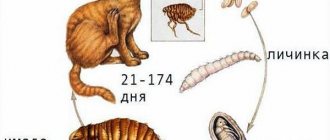During its life, one ladybug can eat about a thousand garden pests. But nutrition depends on their type:
- 68% (Scymnus, Platynaspini, Coccidulini, Coccinellini) feed on aphids (Aphidoidea);
- 18% (Nephus, Hyperaspini, Noviini) feed on a variety of scaly insects (Coccoidea), with some ladybugs feeding on both leaf and scale insects;
- Others eat mites (Stethorus pusillus), moths (Clitostethus arcuatus) or leaf fleas (Calvia quatuordecimguttata);
- The beetle family Halyziini feeds on ascomycetes (Ascomycota) and flowering plants.
They consume both adult insects and their larvae. Cannibalism sometimes occurs in predatory species of cows.
It has been documented that adult beetles can consume plant pollen.
Ladybug eats aphids
History of the name
If we consider the Latin name of the insect, in translation it means “scarlet”, which corresponds to the color of the bug. And the popular name appeared quite a long time ago due to sympathy for this insect. In Germany and Switzerland, the creature is called the “Virgin Mary’s bug”; in Slovenia and the Czech Republic, the insect is known as the “sun” (as many are accustomed to calling the ladybug in Russia). This creature also lives in Latin American countries, and they call it “St. Anthony’s bug.”
The origin of the domestic name ladybug is currently unknown. Some researchers believe that the bug received this name due to its ability to destroy aphids. Thus, a simple creature helps preserve huge crop plantations. It becomes clear what ladybugs eat.
Lifestyle of a dangerous pest
Their body is either transparent or takes on the color of the plant being consumed. All aphids feed on the sap of plants, destroy their foliage, interfere with its growth and development, and can infect the plant with a virus, which will destroy it (you can find out more about what aphids feed in nature here).
In addition, aphids are divided into winged and wingless. Aphids reproduce very quickly and live in large colonies. A warm and humid climate is most acceptable for them, only in it they reproduce successfully. Aphids feed on young shoots and green leaves. And their favorite shoots are viburnum, linden and plum.
Traces of their vital activity are loved by ants. They are ready to faithfully follow and protect their supplier of the delicacy. Protect from winter frosts in your home, anthill, or from attacks from ladybugs and lacewings. You can learn more about the symbiosis of ants and aphids here.
Basic characteristics of an insect
A ladybug is a small bug, the length of which does not exceed 10 mm (in most cases it is about 6 mm). The insect has an oval or round body shape. Some species have fine hairs on the top of their wings. The body of a ladybug consists of a head, pronotum, chest, three pairs of legs and wings. The insect has a motionless head. The ladybug has relatively large eyes and antennae that are highly flexible.
Thanks to three pairs of legs, the insect can move quite quickly on grass and ground, and a little worse on sliding surfaces. Thanks to two hind wings, ladybugs move perfectly through the air.
The insect has an excellent defense mechanism against predators (animals, other insects, birds). The bug secretes a toxic yellow liquid with an unpleasant odor. The bright colors of the ladybug, beloved by many, also scare away enemies.
Habitat
What does a ladybug eat in nature? It all depends on where exactly the insect is located. These bugs feel great almost anywhere in the world. They are only absent in Antarctica. Ladybugs can be found in large numbers in America, various regions of Europe and Asia. Such insects live in all countries of the former Soviet Union. They also exist on Russian territory.
Most often, insects choose to live on plants on which a colony of aphids settles. Some species prefer to settle on reeds near water bodies or in field grasses. Almost all insects lead an isolated lifestyle. They do not like to depend on their relatives. Insects gather together only during the mating season. All types of ladybugs are heat-loving. Before the onset of winter cold, insects gather in huge flocks and fly away for the winter.
Some subspecies remain to winter in Russia. Ladybugs gather in huge communities, choosing stones and tree bark as shelter. However, insects do not live long. Under favorable conditions, their life expectancy does not exceed a year. Most often, the insect lives only a few months.
Reviews
“We have been fighting the Colorado potato beetle for a long time using various chemicals. All this helped with varying degrees of success. Then, we decided to get guinea fowls, at first we thought about turkeys, but abandoned this idea, because they need more and more frequent care. Guinea fowls are not whimsical; in addition, they cope well with the responsibility assigned to them.
“I, too, not so long ago decided to get this poultry, but no one told me that if you decide to get guinea fowl, you need to trim their flight wings, because they have not forgotten how to fly compared to chickens. Otherwise, everything is fine, these birds practically do not get sick and do not require special and constant care.”
“Poultry, of course, helps in pest control, but I prefer other methods. When planting potatoes, I usually place 1 - 2 beans in a hole. This works well to repel the Colorado potato beetle. And I use domestic birds, whether guinea fowl or chickens, as an additional means.”
Ladybug feeding
Despite its pleasant appearance, the bug is a predator in the world of insects. Almost all species of this bug eat mites and aphids; they can also eat butterfly eggs; small caterpillars are a real delicacy. If there is no alternative food, ladybugs do not disdain the eggs of the Colorado potato beetle.
There are also subspecies of this insect that feed exclusively on plant foods. The beetles' diet includes leaves, inflorescences and plant pollen. Some insects can eat even small fruits.
Are you really human?
At the same time, every day she feeds on aphids. By the end of the second week, the larva fully matures and transforms into a pupa. The cocoon is usually located in an open place. Ladybugs are small insects well known for their bright colors and lack of fear of humans. By the way, the number of spots has nothing to do with the age of ladybugs, as many children, and adults too, think. In temperate zones, the lifespan of most ladybugs is about a year, but some centenarians, under favorable conditions, live up to two years.
Everyone loves ladybugs because of the spots that decorate their backs. However, these cute bugs often eat each other - and are also infected with blood-sucking mites, warns a BBC Earth correspondent.
The diets of coccinellids are also quite varied. Ladybugs with 24 spots eat plant matter.
Stages of ladybug development
By the fifth month of life, most insects of this species reach sexual maturity. Ladybugs actively breed already in April. The bugs gain strength after hibernation and only then begin to mate. The ladybug feeds especially intensively at this time to produce healthy offspring. Thanks to the specific aroma, the male easily finds the female. The eggs are laid near aphid colonies so that in the future the young ladybug can fully feed (what the insect eats was described above). Typically, eggs attach to the underside of plant leaves. One female can lay up to 400 eggs, then she dies.
After just a few eggs, bright ladybug larvae emerge from the laid eggs. What is an insect? From the first days of life, the larva can feed on aphids and pieces of plants. The larvae can also eat the shell of the egg from which they hatched. Of the many eggs laid, not all of them fully develop; some of the embryos die. Mature larvae can also feed on these remains.
From the moment the larva appears until the full-fledged bug matures, at least a month passes. The larva pupates, and a week later a normal ladybug is born. What does a young insect eat? It all depends on the species. If it is a predator, then it will continue to feed on aphids and mites.
Is it possible to use chickens against the Colorado potato beetle?
In order to destroy the Colorado potato beetle, ordinary, well-known chickens began to destroy them, they must first be trained to do this. If this is not done, the larvae will remain on the potatoes.
In order for chickens to get used to fighting Colorado potato beetles, they need to start training them at 3-4 months of age.
The training is quite simple:
- First you need to crush the beetle larvae and add them to the chickens' feed.
- At the second stage. You need to add potato tubers or tops to the feed. This way, the chickens will get used to the potato smell.
- After a week, the amount of supplements can be increased.
- When the chickens get used to the potatoes and larvae, they can be safely released onto the site.
We suggest you read: What is the name of the medicine for lice?
Important: if a decision has been made to use poultry in pest control, then it is imperative to avoid using chemicals.
As you can see, chickens can not only be used against the Colorado potato beetle, but, most importantly, they must be accustomed to it.
The benefits and harms of ladybugs
These insects are quite voracious. Thanks to this property, it is possible to maintain the full development of vegetable gardens and orchards and protect them from aphid invasion. Just one ladybug larva per day can destroy more than 30 aphids. An adult bug can easily cope with a hundred or more pests. To clean up industrial areas, ladybugs are bred in special enterprises. The bug is spread throughout the fields by aviation on a huge scale.
Ladybugs, which prefer plant foods, are not at all harmless. They live mainly in Latin America, as well as in some regions of South Asia. Such insects cause enormous damage to agricultural land. Such ladybugs are capable of destroying tomatoes, potatoes, cucumbers, and beets.
Let's discuss!
Why do food chains start with plants?
Any food chain begins with plants, because they are the only producers of organic food. Only plants can produce organic nutrients from carbon dioxide, water and sunlight.
What would happen if there were no frogs, snakes, owls, or dragonflies left on Earth?
- If there were no frogs left on earth, then snakes would have nothing to eat, and they would die out. But there would be a lot of mosquitoes.
- If there were no snakes left, the frogs would multiply and they would no longer have enough food. They too would begin to die out.
- If there were no owls left, mice would breed and the crops in the fields would perish.
- If there were no dragonflies left, then mosquitoes and flies would breed in huge numbers, which can be carriers of various diseases. And the birds that feed on dragonflies would die of starvation.
Interesting facts about ladybugs
Although this bug is a predator, it can also be endangered. Who eats ladybugs? Some species of birds (including sparrows) are especially dangerous for them. Certain types of flies also feed on ladybug larvae.
In most countries, this insect is respected and even idolized. Many people believe that this insect is a symbol of good luck, so it should never be harmed. The ladybug was depicted on clothing, shoes, and jewelry. This was considered a talisman. Numerous signs associated with this bug have been preserved to this day. So, a ladybug that lands on your hand cannot be chased away. It is believed that by doing this, a person pushes away fortune.
How to attract beneficial insects?
In addition to aphids and insects, ladybugs also eat pollen. And the pollen of some plants is preferable to them than the pollen of others. Examples of herbs that can be planted in your area to attract beetles include:
Calendula is a perennial herbaceous plant. Grows well in bright sun. Blooms in a lush bright orange palette. Attracts ladybugs.- Dill is an unpretentious green plant that is extremely effective in attracting beetles. A widely used spice.
- Cornflowers are a perennial plant that attract ladybugs well.
- Coriander is a wonderful spice that attracts beetles during flowering and growth.
- Geranium - this unpretentious plant will also help you attract ladybugs.
- Tansy is a decorative and quite useful plant in our topic.
- Dandelion - surprisingly, but the herbaceous plant so familiar to us is also extremely effective in exterminating aphids.
- Cosmea - this amazing flower can become not only a wonderful garden decoration, but also an equally pleasing protector.
- Yarrow is one of Ladybug's favorite plants.
- Mint – This herbal tea will help you at dinner and provide a complete meal for Coccinellidae.
- Fennel is a medicinal plant that requires fertile soil and warmth, but more than pays for these efforts with a good indicator of ladybug immigration into your territory.
- A succession of sun-loving decorations for your garden will also serve as an excellent bait for beetles. Among garden herbs, this flower will stand as a beacon for cows.
If you want your vegetation to be favored by ladybugs, then:
- Never use insecticides. These products affect both harmful and beneficial insects. And they last a long time after use.
- You can also buy or transfer beetles from stores or other people's lands, naturally, with the permission of the owner of the beetles.
- Ferramonium baits can also be used. They also show themselves to be an effective measure in attracting ladybugs. It is preferable to combine it with the first advice on planting certain varieties of plants on your site.
